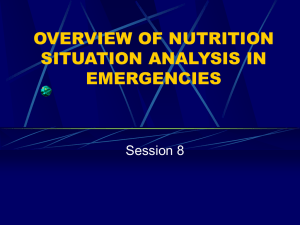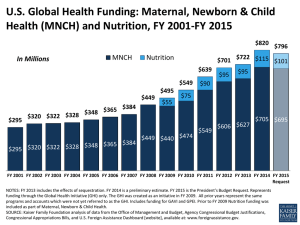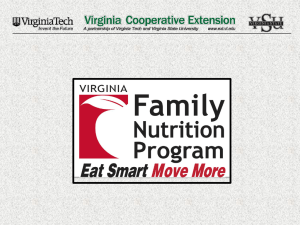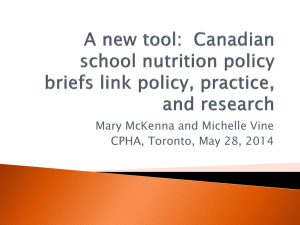Capacity Building Experiences in LAOS
advertisement
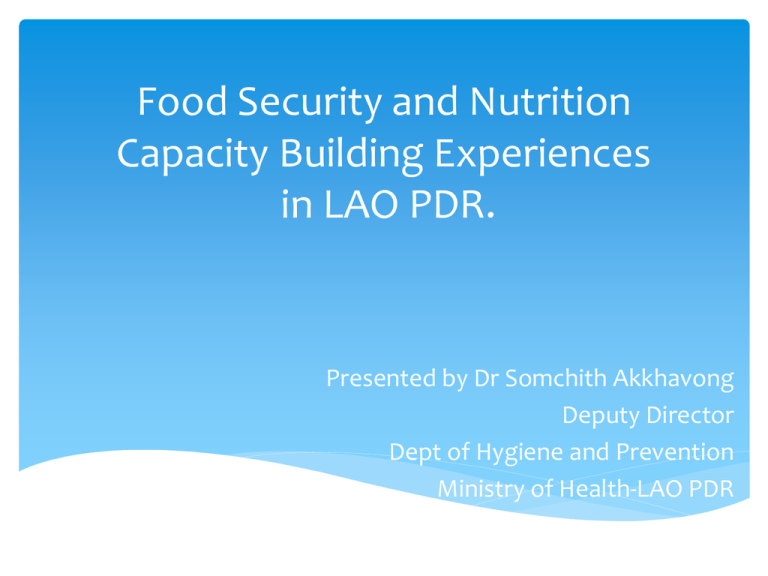
Food Security and Nutrition Capacity Building Experiences in LAO PDR. Presented by Dr Somchith Akkhavong Deputy Director Dept of Hygiene and Prevention Ministry of Health-LAO PDR Outline of the Presentation I. Background II. Goals and objectives III. Target areas IV. Implementing Partners V. Key activities VI. Lessons learned VII. Recommendations National Nutrition Strategy (NNS) National Nutrition Strategy Strategic Direction I Strategic Direction II Strategic Direction III Address immediate causes Address underlying causes Address basic causes Strategic Objective 1 Strategic Objective 3 Strategic Objective 7 Improve Nutrient Intake Improve food availability Improve institutions & coordination Strategic Objective 2 Strategic Objective 4 Strategic Objective 8 Prevent and reduce food and vector-borne diseases Improve food access Improve human capacity Strategic Objective 5 Strategic Objective 9 Improve mother and child care practices Increase quantity and quality of Information Strategic Objective 6 Strategic Objective 10 Improve environmental health Increase investments in nutrition 3 Capacity Building is one of the 11 bundles of nutrition intervention identified as priority in NNS The TARGET of Capacity Building Individuals, communities, and institutions that work directly and indirectly influence FNS situation at the local level National Policies and Programs Lao PDR made significant progress in nutrition and food security over the past two years 12 / 2008 National Nutrition Policy 10 / 2009 10 / 2009 National Plan of Action on Nutrition Capacity Building Framework for Food & Nutrition Security , 2011-2020 GOAL To improve food and nutrition security of low-income rural families in areas with high concentration of malnutrition Objectives To build institutional and individual capacity and coordination regarding food and nutrition security; To increase knowledge on food and nutrition security concepts at the national and sub-national levels; To develop capacity for integrating food and nutrition security into national development policies, strategies, plans and programme ; To build capacity for generating information on food and nutrition security for appropriate assessment, monitoring and evaluation; and To increase technical knowledge and develop relevant skills on food and nutrition and related topics specifically, food – based interventions 3 main regions have different undernutrition characteristics North 34% Criteria of target areas selection ~87,000 children • High prevalence of Malnutrition • High prevalence of poor households • Agro-ecological setting • Wide range of ethnic diversities • Potential for agriculture • Accessibility • Political leaders are willing to participate Central 33% ~107,000 children South 50% ~74,000 children 8 Organizational Structure Steering committee (overall guidance) MPI, MAF & MoE, MoH CHAIR; reps of the Ministries: reps of participating national organizations: reps of FAO PROJECT NANAGEMENT UNIT (MANAGEMENT & COORDINATION) National Project Dir. MOH Int’l Technical Advisor Nat’l Deputy Director, MPI Nat’l Associated Director (inter-sectoral coordination) MoE (Education-related issues Nat’l Deputy Director, MAF Int’l/Nat’l Experts (Implementation at Nat’l/ Nat’l organizations (Implementation at village Provincial levels) Levels) Key activities Capacity –building in Improved Nutrition Counseling Using Trials of Improved Practices Capacity-building in sustainable home food production Capacity-building in simple, home based food processing Capacity-building for effective and efficient program management Key strategy Setting up of selection criteria using nutrition, health indicators and practical considerations Courtesy call to provincial /district officials/data collection and reconnaissance visits Selection of villages Community Assemblies for Project Orientation and social mobilization Key strategy (cont.) Development of Training materials -> translation and adaptations of some FAO developed materials -> development of new materials Pretesting of Training Programme and training materials Revision/Finalization based on evaluations conducted Training Materials developed Translated and adapted Family Nutrition Guide Healthy Harvest Assessment Tool Field Programme Management : Food, Nutrition and Development Publications Training Needs Assessment report National Multisectoral Capacity-building Plan (both documents are available in English and Lao) Training Materials Basic Nutrition Training Guide Food and Nutrition Programme Management Counseling Guides 8 kitchen tested, standardized recipes for complementary feeding 8 kitchen tested, standardized recipes for food processing Seasonal Food Calendar Challenges Low knowledge on nutrition and food security Illiteracy of target groups Transportation particularly during rainy season Irregular field visits due to logistic constraints Limited project funds which limited inputs that can be provided. Low capability of Staff in term of management and technical Linking food security and nutrition understanding is very low Lessons Learned Political commitment Well-functioning organization , preferably with a network that extends to the village level can contribute to program success Leadership in nutrition needs to be developed to create nutrition champions/advocates Active participation of the people at grassroots is an important ingredient in community-based programs Incentives are needed to motivate target groups and partners Lesson Learned (cont.) Orientation and training are key to project initiation Coordination, supervision (through regular meetings/dialogues) and regular technical backstopping is essential particularly for multisectoral programs Information support and pilot studies that highlight best practices for effective planning, implementation and evaluation are needed Monitoring and evaluation should be built into the project Lesson Learned (cont.) Process documentation should be a regular component of any project to identify best practices Coaching/mentoring are effective strategies for capacity-building Trainings, based on a well-conducted training needs assessment ensure the development of responsive programs Learning by doing is a very effective way of changing behavior and works well at the village level Recommendations Creation of multisectoral TWG on capacity-building as agreed during multisectoral consultation meeting ( partnerships with LWU, local civil society organizations) The duration of project should be more longer for Strengthening the technical and managerial capacity. Need intensive support from Development partners THANK YOU




